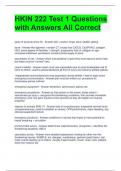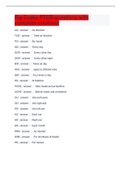HKIN 222 Test 1 Questions
with Answers All Correct
types of synovial joints (5) - Answer-ball + socket, hinge, pivot, saddle, gliding
bone - Answer-like ligament + tendon CT, except has CaCO3, Ca3(PO4)2, collagen,
H2O. some degree of flexibility + strength. progressive loss of collagen w/ age -
increases brittleness. periosteum contains blood supply to bone
assumption of risk - Answer-when one partakes in sport they must assume some risks,
but these must be "normal" risks
coach's liability - Answer-coach must use reasonable care to avoid foreseeable risk of
harm to others. coach's actions/decisions @ time of injury are critical to athlete welfare.
inappropriate actions/decisions may jeopardize injured athlete + lead to legal action
emergency communication - Answer-plan must be written out, procedure for
home/away games outlined
emergency equipment - Answer-stretchers, spine board, splints, etc
emergency procedures - Answer-as first person on the scene, asses extent +
seriousness go injury + recognize life-threatening conditions, then provide immediate
emergency care. few sport injuries of this severity but they do happen so must be
prepared
reasons to activate EMS (7) - Answer-loss of consciousness, suspected cervical injury,
unresponsiveness, need to establish an airway, CPR performance, major bleeding, any
obvious/suspected fracture
emergency situations - Answer-conditions or injuries that impair or have potential to
impair breathing + circulation
primary/initial survey - Answer-determines responsiveness, recognizes + identifies life-
threatening situations, ABC's
secondary survey - Answer-more detailed assessment, looking for other non-life-
threatening injuries. SAMPLE: s/s, allergies, medications, pertinent past history, last
meal, events leading up to history. visually inspect pupils, mouth, nose, neck. palpate
body from head to toe
, responsiveness - Answer-before making decisions about rendering care, it's essential to
determine level of responsiveness. AVPU - alert/aware, responds to verbal stimulus,
responds to painful stimulus, unresponsive t any stimulus
tort - Answer-harm done to another for which the law holds the wrongdoer responsible
negligence - Answer-failure to do what a reasonably careful/prudent person would have
done under similar/the same circumstances OR doing something a reasonably
careful/prudent person wouldn't've done under similar/the same circumstances
act of commission - Answer-acting in an improper way
act of omission - Answer-failure to act
liability - Answer-the state of being legally responsible for the harm one causes another
person
law suits - Answer-measured against a standard of care
standard of care - Answer-what another minimally competent individual educated +
practicing in that profession would've done in similar/the same circumstances to protect
the individual from harm/further harm
potentially negligent actions (7) - Answer-failure to: provide competent personnel,
provide instruction, provide proper equipment, warn, supervise, properly treat an
athlete. selecting participants
Good Samaritan Law - Answer-developed to protect citizens who voluntarily provide first
aid to an injured person. coaches + other school personnel not covered under this
reducing risks (8) - Answer-coaches, first aid training/emergency plans, constant
supervision, proper conditioning, instruction of skills, proper use of equipment/facilities,
parental consent forms, education of coaches/seminars
athletic therapists + liability (9) - Answer-EAP, record accidents, medical history/PPE,
supervision, work w/ in scope of practice, don't use faulty equipment, work w/ coaches +
medical staff, don't allow injured players to play, don't assist in dangerous/unethical
performance enhancement
extrinsic injury causative factors (4) - Answer-equipment, environment, activity type,
conditioning errors
intrinsic injury causative factors (7) - Answer-age, gender, body size, injury history,
fitness level, skill, psychological status





